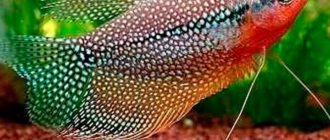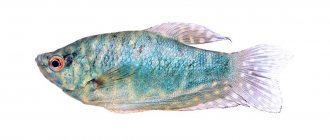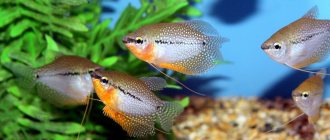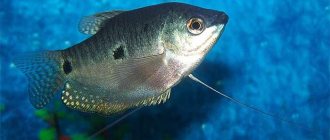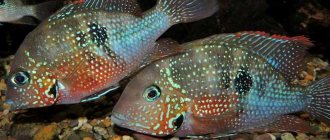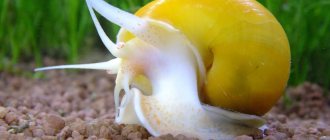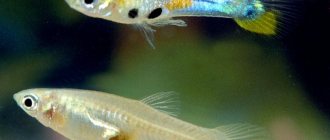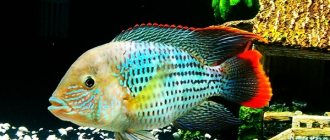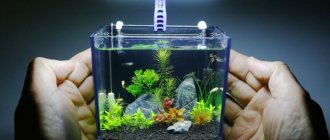If you are interested in gourami aquarium fish, then you have come to the right place. In this article you will probably find all the information you are interested in and many interesting facts. Moreover, to the list of this information we will add a short overview about all types of gourami.
Let's start with the fact that gourami is one of the most popular varieties of aquarium fish.
The gourami fish is a phylum of chordates, a class of ray-finned fish. In addition, speaking about these fish, it is also worth mentioning that all these types of gourami belong to the order Perciformes.
As for keeping gourami fish, you will probably be pleased with the fact that they are quite unpretentious, which makes them qualitatively different from many other marine inhabitants. That is why they are so readily recommended to beginners and insufficiently experienced fish lovers.
Helpful information
A long time ago, one famous French explorer and scientist, known as Pierre Carbonnier, dreamed of bringing to Europe one exotic and unusual type of fish known as gourami, the species of which, as it turned out, are not so few.
So, this same scientist was faced with one seemingly insurmountable problem, which was transporting caught fish over long distances. No matter what tricks they tried to deliver them to Europe, the fish invariably died at the beginning of their journey.
That is why it was decided that they were quite problematic and not adapted. However, as time has shown, this conclusion turned out to be rash and premature.
So why, despite the fact that gouramis can live even in dirty ponds, do they not tolerate comfortable transportation conditions?
The answer to this question was found completely by accident. As it turns out, for this type of fish it is very important to have access to air. It was only after a certain amount of time had passed that they were observed to float to the surface from time to time to grab an air bubble.
In accordance with this observation, it was decided to try to transport them not as it was done before, in barrels filled to the top with water and covered with a lid on top, but in half-empty ones. Thus, the fish had the opportunity to capture air bubbles during transportation.
This experiment turned out to be more than successful. During the entire journey from the place of catching to Europe itself, not a single specimen died. It was in this simple way that the fish reached Europe at the very beginning of the nineteenth century.
Breeding
Gourami reach sexual maturity at 8-14 months, depending on the breed. Sexual dimorphism is usually poorly developed, but the male always acquires a brighter color before spawning, except for the Vaillants.
In most species, the main role in obtaining and caring for offspring belongs to the male individual. It is the male who builds unique nests from foam, air, and pieces of plants and protects the clutch. Only in some varieties both parents or only the female participate in active care of the offspring.
It is better to place the pair ready for the mating season in the spawning area. The following requirements apply to it:
- sufficient volume - 40-60 l;
- water height is about 30-35 cm;
- the liquid must be fresh and settled and part of it must be renewed daily;
- future parents should be fed only live food.
After the courtship period is completed and the male builds a nest, the female lays up to several thousand eggs in the water.
The male shoos away the mother and collects the larvae with his mouth, carefully transferring them to the foam-air nest. The female can be removed immediately, and the male can be removed after 3-4 days, when the fry hatch and begin to swim, they will no longer need the care of their father. After eating the yolk sac, the juveniles begin complementary feeding - they happily eat nematodes and ciliates.
This is a general breeding pattern, but it should be remembered that depending on the variety of Diverse Gourami, spawning conditions may vary. In some individuals the mating season lasts up to 6 months, and in Sphaerichthys the eggs are generally carried by the mother in her mouth.
Habitat
It should be remembered that gouramis are divided into species, and therefore their natural habitat also differs.
Generally speaking, they mainly live in water bodies of Southeast Asia. If we are talking about any species, then they tend to live only in certain areas.
For example, the moon gourami lives mainly in reservoirs in Thailand or Cambodia. The serpentine gourami, in addition to the countries mentioned, can be seen in southern Vietnam. Spotted gourami can be found both in India and in the Malay Archipelago. The blue gourami is found in Sumatra. The serpentine gourami lives in the waters of the Antilles and Central America.
As for the reservoirs themselves located in the countries listed above, it is worth noting that these are quite adapted fish, accustomed to living in both calm waters and rivers. Moreover, for the most part, even the volume of the reservoir does not matter at all. It can be either some small lake or a large spacious reservoir.
For example, spotted and brown gourami have chosen coastal waters, which differ from most bodies of water in their high content of sea salt.
Absolutely incompatible
Gourami cannot get along with large fish, predators and aggressive species that conflict with each other and other fish.
Neighborhood is completely excluded:
- cockerels;
- goldfish;
- koi carp;
- astronotuses;
- African and South American cichlids.
Giant Astronotus are completely incompatible with gouramis and other small varieties.
Information about fish
When it comes to thread-bearing gourami, then first of all it is worth noting that these are exclusively freshwater fish, the body length of which ranges from five to twelve centimeters inclusive. However, this is far from the limit for the body dimensions of the described species of fish. Some individuals of other species can reach an impressive twenty-five centimeters in length. Such a giant gourami lives in the reservoirs of Vietnam and Thailand.
Moreover, there is such a variety of fish as the giant gourami, which grows to almost fifty centimeters in length. Sometimes this type of fish is called nothing other than commercial gourami.
However, despite the fact that the size of the fish can vary quite widely, individuals with a body length not exceeding ten centimeters are usually selected. This size is considered not only optimal, but also suitable for a regular aquarium for gourami. At the same time, in some cases, giant gourami is also brought to order, the demand for which is much lower.
It is worth noting that gourami is a real record holder among most species of fish that can survive for a long time without the usual aquatic environment. This feature is connected with the fact that the common gourami and other varieties contain a special organ in the structure of their body that helps them stay alive for a long time in water with a minimum content of oxygen necessary for them.
Thus, the common gourami can go without water for up to eight hours. However, this should not be tested experimentally. Fish are living creatures and must be treated as such.
It is precisely because of the above-described feature that the common gourami could not be brought into Europe for a long time.
This labyrinthine organ develops in fish as they grow. In the first weeks of life, it is simply not there, or rather, it is not yet sufficiently formed.
Appearance
An adult gourami, photos and videos of which can be seen on our website, has a number of structural features of its body.
As is the case with most marine life, this fish has an elongated and at the same time flattened body at the edges. As for the characteristic differences between the male and female, the former has a noticeable elongated dorsal fin. In the female it is not only much shorter, but also slightly rounded.
In addition, a characteristic difference between a male and a female is their coloring. In males it is more intense and bright, in females, on the contrary, it is more faded.
The most common and well-known types
It's no secret that there are a number of varieties of gourami, differing from each other both in the size of their body and in their characteristic appearance. We will talk about the most remarkable and beautiful species of this fish in this section.
Spotted
Spotted gourami is characterized by the presence of a number of subspecies, the distinguishing features of which are different color variations. In this case, you may see a fish with a very remarkable color: blue, white or even yellow gourami. However, sometimes it is also called mother-of-pearl gourami, for its characteristic coloring.
In addition to the spotted one, there are three more true species of this variety of fish, which include moon gourami, brown gourami and pearl gourami.
The remaining varieties of these fish are considered, a kind of false gourami. However, they still belong to the described class of aquatic inhabitants. Thus, you have probably heard about the following types of fish.
Varieties of gourami
As mentioned above, “gourami” are four species from the genus Trichogaster:
The spotted gourami is an energetic and fairly large silver-colored fish with spots on the tail and subtle dark stripes.
Brown gourami. The body length of this fish can easily reach 16 cm in aquarium conditions, so it can rightfully be called the largest representative of the entire species. Despite its size, the serpentine (brown) gourami is a peace-loving fish that does not really like bright light.
The pearl gourami gets its name from the small white spots that look like pearls, which are located on the body of the fish.
Moon gourami has a silver body with a greenish tint. Males have a faint orange tint on their ventral fins.
Gourami also includes closely related species, for example:
The kissing gourami was named so due to its interesting form of behavior. Sometimes the fish come up to each other, swim side by side, and then at one moment lock their mouths. In fact, this is not “love” at all, but an attempt to establish one’s social status in the pack;
Grunting gourami - the name speaks for itself: the fish makes grumbling sounds reminiscent of the croaking of a frog. “The Grumpy” emits them while in an excited state, swimming at night to the surface of the water to capture the next portion of air;
The dwarf gourami is a miniature fish compared to its relatives, which grows no more than 4 cm;
Honey gourami is unpretentious. It got its name due to its color. Females and young fish are silver-brown in color with a chocolate stripe along the body. Adult males are honey-colored, the underbelly, head, and most of the anal fin are black-brown. The dorsal fin has a white and yellow border. Because a female and a male of different colors, at first it was believed that these were representatives of different species.
You should know that there are color varieties of spotted gourami: blue, gold, marbled, etc.
blue gourami
golden gourami
marble gourami
Keeping in an aquarium
Oddly enough, not only small individuals are kept at home, but also quite large ones. For example, if you wish, you can easily keep a fish such as commercial gourami. However, for its successful maintenance it will be necessary to fulfill a number of conditions.
Surely you have noticed that at an early age their body length does not exceed ten centimeters. Perhaps this is why you might have purchased a small aquarium. In this case, you would be acting rashly, since adult fish need a lot of space.
Multi-liter aquarium options, for example, eight hundred or more liters, will be optimal. This is due to the fact that within four to five years, the length of their body will increase significantly and reach fifty centimeters or more.
A characteristic feature of the described species of fish is their inherent individuality. They can easily get used to the person feeding them and even eat from his hands.
If you become the happy owner of a small fish or some other species, then small aquariums with a capacity of twenty or thirty liters are also suitable.
The water in the aquarium should be regularly cleaned and be at approximately the same temperature, within the range of twenty-six to twenty-eight degrees Celsius. There should be some kind of vegetation in the aquarium. Among the other fish added to the aquarium, there should not be any predator that can cause harm to your fish.
Don't forget about appropriate lighting. Fish need the aquarium to be lit for 12 hours every day.
If you ask how long gourami live in a comfortable environment for them, you will certainly find the answer. On average, their life expectancy ranges from five to seven years. However, if you create comfortable conditions for him, he can live up to ten years.
Neighbors with good compatibility
When creating an aqua system, you need to consider who the gourami gets along with in the aquarium. The peace of the aquarist himself and his pets will depend on this. The compatibility of gourami with other fish largely depends on the volume of the aquarium and the amount of vegetation inside. The larger the container and the denser the thickets, the less will be the threat of constant skirmishes and quarrels.
Gourami are calm fish, but male gourami can get into fights over females.
For these fish, it is advisable to plant 60-80% of the entire area of the aquarium with plants and create a slight current using a special attachment on the filter. Small fish that live in the lower and middle layers of water are ideal for labyrinths as neighbors.
Here's who you can keep gourami with:
- minors;
- tetras;
- iris;
- neons;
- battles;
- swordtails;
- platies;
- zebrafish;
- catfish.
It is also permissible to add some types of barbs. Angelfish and some other small cichlids will also get along well with gouramis. The aquarium must have a lid or cover glass, since labyrinthine representatives can jump out of the water.
Fish food
In this section you will find information on what to feed gourami. Despite the fact that they are very unpretentious inhabitants of the underwater world, they should be pampered from time to time with such feeding as bloodworms or daphnia.
However, the food should always be as balanced as possible. The fish's diet should always contain both dry and live food. Moreover, some species of the described species of fish are characterized by different dietary features. Some of them need more protein, others need plant ingredients.
If you are in doubt about the correctness of the diet you have chosen for your pet, then purchase any ready-made mixture of food sold in any pet store. The only thing you need to pay attention to is what expiration date the food has and what type of fish it is most suitable for. This is the only way you can purchase sufficiently high-quality fertilizer.
